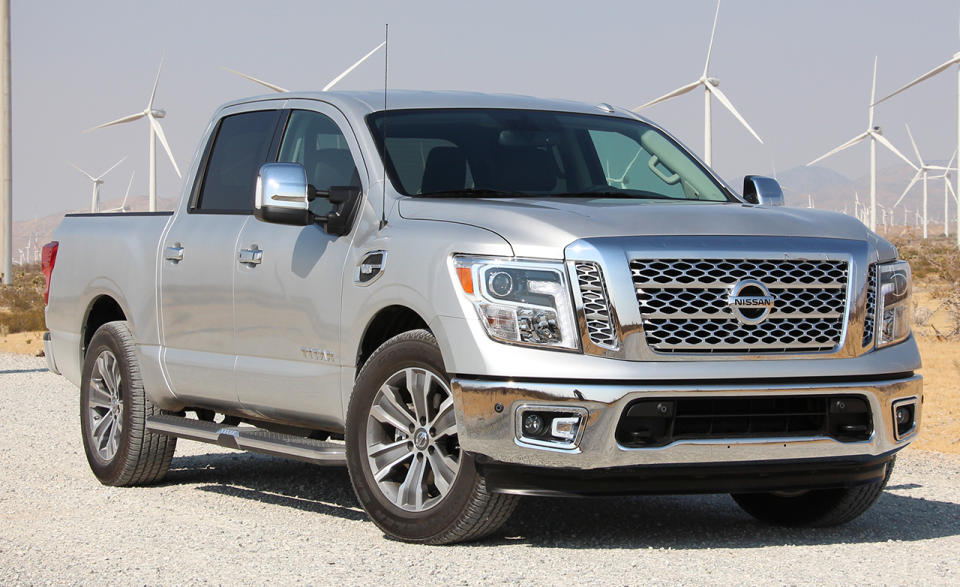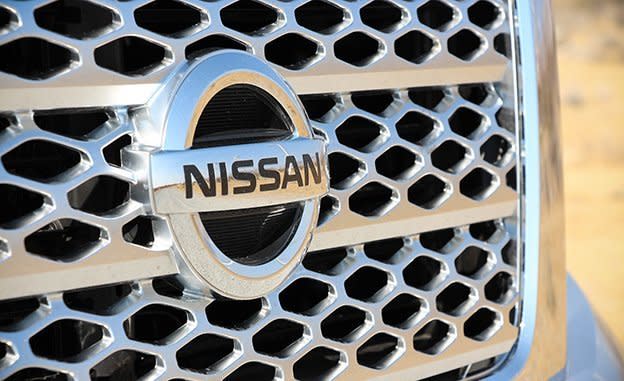2017 Nissan Titan 4x2

A contagion infects all of America’s latest full-size pickup trucks. What were once boring machines built for utility are now the most overstyled, oversize, and overwrought of vehicles. Look at the 2017 Nissan Titan. An entire steer could be barbecued on its grille, were that component not made out of easy-melt shiny plastic. The fenders are as tall and square-shouldered as a Cleveland Browns lineman. If any button were bigger on the instrument panel, it could be engaged with a sledgehammer. The heavy steering feels as if you’re pulling against a black hole’s gravity. Aliens couldn’t undermine humanity’s faith in our own self-restraint any more convincingly. Someday, all this will be regarded as an era of unbridled excess every bit as flamboyant as the big fins and shiny chrome of the 1950s—and probably with as much nostalgia.
The SL tested here is the mainstream Titan. Assembled in Mississippi, it’s a half-ton crew cab with rear-wheel drive and leather upholstery that’s well equipped—although not ridiculously lavish in the manner of the line-topping Platinum Reserve. In 2004, the first-generation Titan was regarded as a landmark challenge to the one market segment Detroit automakers still dominate. Now? It's just another player, and a small, bit player at that.

The standard-issue civilian truck shares its Tennessee-built 5.6-liter V-8 with its almost-three-quarter-ton sibling, the Titan XD, which garners more headlines for daring to bump up into the lower end of the Detroit-ruled heavy-duty segment. What this regular-duty truck doesn’t share with the XD are the Cummins diesel engine option, some body panels, and a beefier frame and suspension. It’s also 14.7 inches shorter overall on a wheelbase almost a full foot shorter than the Titan XD's with its longer bed.
This new Titan carries over several features from the first-generation model. It still rides on the same 139.8-inch wheelbase, employs the same basic steering elements and general suspension design (unequal-length control arms up front, leaf springs positioning a live axle in the back, as is the norm for pickups), and casts a similarly shaped shadow. But this Titan isn’t strictly a rerun, either. It’s 3.5 inches longer than the previous-gen crew cab with a similar 5.5-foot bed, because bigger seems to be the only direction allowed when it comes to marketing full-size pickups. Its rack-and-pinion steering gear remains hydraulically assisted, but it’s been quickened from 19.5:1 to 16.0:1 (and that knocks down the number of turns from lock-to-lock from 3.6 to 3.0). The former five-speed automatic transmission has been swapped out for a new seven-speed unit, and the 5.6-liter V-8 has been significantly revised to add power and improve fuel economy.
The 5.6-liter V-8 in the old truck was the VK56DE with a conventional fuel-injection system and a 9.8:1 compression ratio. It was rated at 317 horsepower. The new truck’s VK56VD uses a modified aluminum block, has the same bore and stroke dimensions, and its four-valve, DOHC heads have been revised. The big changes come with the adoption of variable valve timing, direct fuel injection, and a thump up in compression ratio to 11.2:1. All that yields 390 horsepower and 394 lb-ft of peak torque.

At 5754 pounds the Titan is no lightweight, but this engine upgrade ensures it’s no slug. It galloped to 60 mph in 6.0 seconds and bounded through the quarter-mile in 14.9 seconds at 96 mph. That performance and curb weight neatly cleaves between the two top performers in our last full-size comparison test (the Ford F-150 and Chevrolet Silverado) and the bottom two (the Ram 1500 and Toyota Tundra). But those trucks were four-by-fours, which tempers our enthusiasm for the Titan SL’s performance.
Haul yourself up into the Titan SL’s cab and what’s there is straightforward enough, even if it all seems designed to emphasize the truck’s mass. There’s simply so much dash and the seats are so thick that the space seems smaller than it actually measures. The windshield isn’t small, but it leaves the impression that you're looking through a slit because the dash rises up to intrude from the bottom. This is not a cockpit that can be described as “airy.”
Press the start button and the truck grumbles to life, most of the time. On a couple of occasions while the Titan was in C/D’s care the engine-control computer hiccupped, failing to complete its starting regimen. The engine either dropped off into an irregular idle or shut down. This likely was an anomaly, but it was disconcerting all the same.
But when the engine found its voice, it was an engaging bass, somewhere between the growl of the Tundra’s 5.7-liter V-8 and the eagerness of the current Silverado’s LT-series small-blocks. And it only sounded better as it dragged through the transmission’s seven gears. With the new drivetrain, this truck was rated to carry a payload of up to 1590 pounds, a decrease of 143 pounds over the rear-wheel-drive 2015 Titan SL's rating. In the more-is-better mentality of the current pickup-truck market, these figures matter, and dropping slightly doesn’t put Nissan in any danger of claiming best-in-class numbers. (This truck’s tow rating of 9390 pounds is an improvement of 190 pounds over that of the 2015 Titan SL.)

Where the previous Titan Crew Cab carried EPA ratings of 13 mpg in the city and 18 mpg on the highway, the new one comes in at 15 mpg in the city and 21 on the highway. In mostly light use (no towing, no heavy loads), we used fuel at the rate of 15 mpg.
The SL’s steering feels quite heavy; it responds quickly but communicates only furtively. Punishing the 275/60R-20 Goodyear Wranglers mercilessly produced a so-so lateral acceleration of 0.73 g on our skidpad, a middling grade for any pickup, with expected roll and moderate understeer. Braking from 70 mph to a stop in 195 feet is, likewise, pretty much what one expects in a pickup, the best of which can halt in less than 180 feet, though some take more than 200. Variation here tends to be more about the specific equipment and tire choice than it is between makes and models.
The most frustrating attributes of the Titan SL’s driving behavior can be traced to the suspension tuning. It’s stiff enough that initial bump impacts feel harsh while the dampers don’t quell rebound well, so the front end will porpoise up and down after such events. Hit something like a speed bump at just the right speed and there’s the odd sensation of the nose still bouncing up and down when the tail hits the bump and gets smacked around. This all may calm down while the Titan is loaded, but it feels weird when the truck is unladen. In the Nissan’s defense, the ride is great over smooth and mildly undulating surfaces.
Also arguing on behalf of the Titan SL is its well-considered cargo bed. The tailgate has an assistance spring to ease opening and closing, while LED lights along the bed walls provide outstanding illumination. Add in the Utili-Track rail and cleat tie-downs and this is one of the better trucks for cargo control.

All half-ton 2017 Titans will be crew cabs at first, but Nissan promises that regular and extended King Cab versions are on the way. A V-6 eventually will join the V-8 in the lineup. Currently the announced price of the cheapest rear-wheel-drive Titan S starts at $35,975. It rises up from there through SV, SL, Platinum Reserve, and the four-wheel-drive Pro-4X. At the very top is the Platinum Reserve 4x4 at $56,595. Our test truck started at $47,575 for the SL, which brings leather trim, heated captain's chairs with power adjustments (eight-way on the driver’s side plus power lumbar supports, four-way on the passenger side), and a 60/40 split-folding rear bench. It also includes a power tilting/telescoping steering column, a 7.0-inch color touchscreen with navigation, a 12-speaker Rockford Fosgate audio system, dual-zone automatic climate control, and a host of other interior amenities. The SL's exterior adds a lot of chrome accents and standard running boards. Functionally, the SL includes 20-inch aluminum wheels, a Class IV towing hitch with wiring harness and trailer sway control, a spray-in bedliner, front and rear parking sensors, blind-spot and rear-collision warning systems, and a backup camera. Our example had only one option, the $410 Towing Convenience package, which adds extendable, folding, heated side mirrors with auto dimming; a trailer-brake controller; and front tow hooks. It was, in other words, a mid-grade truck packed with more luxurious comfort and convenience features than you'd find in most family sedans—and suitably so with the bottom line nearing $50,000.
The philosophical conformity of the full-size-truck market is, it seems, one reason the mid-size market has recently returned so robustly. It’s not so much that GM’s Chevrolet Colorado and GMC Canyon models are better-sized trucks, but they run as low-key alternatives to the relentless look-at-me, mucho macho shouting that infests the entire big-truck world.
Nissan has never sold a lot of Titans. So while the half-ton SL likely is going to be the Titan that sells best, in today's elephantine big-truck market, being the best-selling Titan amounts to peanuts. Maybe even a single peanut. Nissan had little to lose; it could have risked being different. And a single peanut isn’t much of a meal for an elephant.
Specifications >
VEHICLE TYPE: front-engine, rear-/4-wheel-drive, 5-passenger, 4-door pickup
PRICE AS TESTED: $47,985 (base price: $35,975)
ENGINE TYPE: DOHC 32-valve V-8, aluminum block and heads, direct fuel injection
Displacement: 339 cu in, 5552 cc
Power: 390 hp @ 5800 rpm
Torque: 394 lb-ft @ 4000 rpm
TRANSMISSION:7-speed automatic with manual shifting mode
DIMENSIONS:
Wheelbase: 139.8 in
Length: 228.1 in
Width: 79.5 in Height: 75.6 in
Passenger volume: 120 cu ft
Curb weight: 5754 lb
C/D TEST RESULTS:
Zero to 60 mph: 6.0 sec
Zero to 100 mph: 16.5 sec
Zero to 110 mph: 21.5 sec
Rolling start, 5–60 mph: 6.3 sec
Top gear, 30–50 mph: 3.2 sec
Top gear, 50–70 mph: 4.9 sec
Standing ¼-mile: 14.9 sec @ 96 mph
Top speed (governor limited): 115 mph
Braking, 70–0 mph: 195 ft
Roadholding, 300-ft-dia skidpad: 0.73 g
FUEL ECONOMY:
EPA city/highway driving: 15/21 mpg
C/D observed: 15 mpg

 Yahoo Autos
Yahoo Autos 